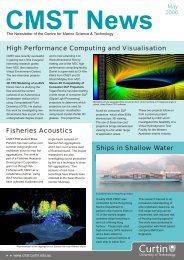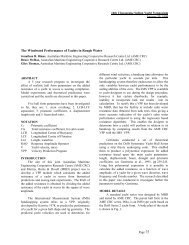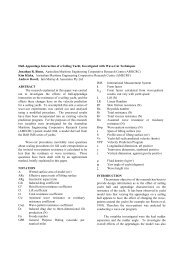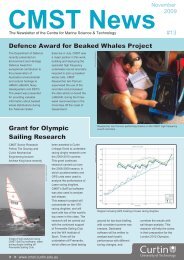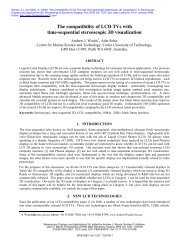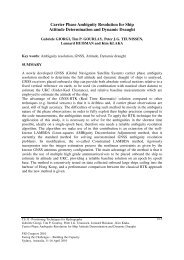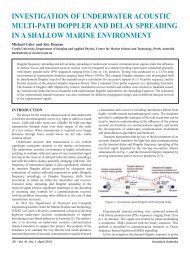Blue whale calling in the Rottnest trench-2000, Western ... - ANP
Blue whale calling in the Rottnest trench-2000, Western ... - ANP
Blue whale calling in the Rottnest trench-2000, Western ... - ANP
You also want an ePaper? Increase the reach of your titles
YUMPU automatically turns print PDFs into web optimized ePapers that Google loves.
Figure 13: Magnitudes of several type II component Hilbert transforms, show<strong>in</strong>g waveform envelope. The<br />
envelopes show large and variable differences <strong>in</strong> level throughout <strong>the</strong> component. This is believed partly a function<br />
of amplitude modulation of <strong>the</strong> signal under <strong>the</strong> animal control, but primarily a sound propagation effect.<br />
3.1.3) Type II received levels<br />
S<strong>in</strong>ce <strong>the</strong> type II component had <strong>the</strong> highest source level it tended to be <strong>the</strong> most common signal<br />
identifiable <strong>in</strong> received spectrograms. Thus much of <strong>the</strong> sound propagation analysis and call<br />
count<strong>in</strong>g techniques were tailored for this component type. For sound propagation analysis it is<br />
necessary to consider <strong>the</strong> frequency structure of <strong>the</strong> signal propagat<strong>in</strong>g, s<strong>in</strong>ce <strong>the</strong> transmission<br />
loss characteristics are frequency dependant. If <strong>the</strong> emitted sound is broadband, or has energy<br />
equally spread across a wide frequency band, <strong>the</strong>n <strong>the</strong> sound propagation needs to be calculated<br />
at representative frequencies and <strong>the</strong> loss for each frequency at a specified range summed to give<br />
<strong>the</strong> result<strong>in</strong>g signal at that range.<br />
For <strong>the</strong> type II component <strong>the</strong> signal tended to be dom<strong>in</strong>ated by <strong>the</strong> 20-26 Hz tone, as shown on<br />
Figure 11 (middle plot). This implies that <strong>the</strong> sound propagation modell<strong>in</strong>g could concentrate on<br />
this frequency band only, and neglect all <strong>the</strong> o<strong>the</strong>r spectral <strong>in</strong>put, such as <strong>the</strong> 48 and 72 Hz tones<br />
seen on Figure 11. If <strong>the</strong>se o<strong>the</strong>r tones were 10 dB less than <strong>the</strong> 20-26 Hz level <strong>the</strong>n <strong>the</strong>y can be<br />
validly ignored, s<strong>in</strong>ce <strong>the</strong>y contribute noth<strong>in</strong>g to <strong>the</strong> decibel value of <strong>the</strong> received signal level. To<br />
check if this applied across a range of signals, <strong>the</strong> start and end time of 107 type II signals with<br />
no distort<strong>in</strong>g or overlapp<strong>in</strong>g sources (boats, o<strong>the</strong>r <strong>whale</strong>s etc) and from <strong>the</strong> bottomed bluey<br />
logger, was determ<strong>in</strong>ed and <strong>the</strong> spectral content of <strong>the</strong>se components calculated, us<strong>in</strong>g a 0.6104<br />
Hz resolution, Hann<strong>in</strong>g w<strong>in</strong>dow and around 16 averages per component. Only <strong>the</strong> portion of<br />
each component which <strong>in</strong>cluded 95% of <strong>the</strong> component energy was used (with <strong>the</strong> sections<br />
averag<strong>in</strong>g at 16 s each). These type II signals spanned a received level of 103-129 dB re 1μPa<br />
(mean squared pressure, see section 3.2 for def<strong>in</strong>ition). Us<strong>in</strong>g decibel statistics (or <strong>the</strong> statistics<br />
calculated on <strong>the</strong> <strong>in</strong>tensities <strong>the</strong>n converted back to dB), <strong>the</strong> mean difference <strong>in</strong> <strong>the</strong> level of <strong>the</strong><br />
spectral peak between 20-30 Hz m<strong>in</strong>us that between 45-50 Hz was 18.18 dB with 95%<br />
confidence limits from 16.5-19.3 dB. Us<strong>in</strong>g <strong>the</strong> same technique <strong>the</strong> mean difference between <strong>the</strong><br />
level of <strong>the</strong> spectral peak between 20-30 Hz m<strong>in</strong>us that between 68-75 Hz was 9.94 dB with 95%<br />
confidence limits of 8.2-11.1 dB. Thus <strong>the</strong> assumption of us<strong>in</strong>g only <strong>the</strong> 20-26 Hz tone <strong>in</strong><br />
propagation modell<strong>in</strong>g was considered valid.<br />
16



